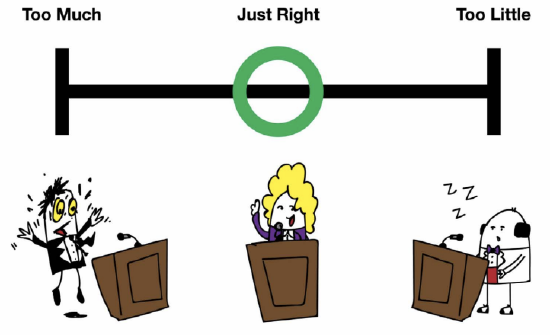14.3: Speech Delivery- Body Language and Voice
- Last updated
- Save as PDF
- Page ID
- 106495
Learning Objectives
- Explain the role of facial expressions and eye contact in speech delivery.
- Explain the role of posture, gestures, and movement in speech delivery.
- Explain the connection between personal appearance and credibility in speech delivery.
- Explain the connection between visual aids and speech delivery.
- Identify elements of vocal delivery that make a speech more engaging.
- Identify elements of vocal delivery that make a speech clearer.
- Discuss the relationship between vocal delivery and speaker credibility.
The interplay between the verbal and nonverbal components of your speech can either bring the message vividly to life or confuse or bore the audience. Therefore, it is best that you neither overdramatize your speech delivery behaviors nor downplay them. This is a balance achieved through rehearsal, trial and error, and experience. One way to think of this is in terms of the Figure \(\PageIndex{1}\): Goldilocks Paradigm: you don’t want to overdo the delivery because you might distract your audience by looking hyper or overly animated. Conversely, someone whose delivery is too understated (meaning they don’t move their hands or feet at all) looks unnatural and uncomfortable, which can also distract. Just like Goldilocks, you want a delivery that is “just right.” This middle ground between too much and too little is a much more natural approach to public speaking delivery. This natural approach will be covered in more detail in the following sections where we discuss specific aspects of your delivery and what you need to think about while actually giving your speech.

Nonverbal Delivery
Many speakers are more nervous about physical delivery than vocal delivery. Putting our bodies on the line in front of an audience often makes us feel more vulnerable than putting our voice out there. Yet most audiences are not as fixated on our physical delivery as we think they are. Knowing this can help relieve some anxiety, but it doesn’t give us a free pass when it comes to physical delivery. We should still practice for physical delivery that enhances our verbal message. Audience members primarily take in information through their eyes and ears. Beyond the actual words of your speech, the nonverbal communication that accompanies your verbal messages affects your credibility.
Gestures
Gestures are any arm and hand movements used during your speech. We all use hand gestures while we speak, but we didn’t even take a class in matching verbal communication with the appropriate gestures; we have just internalized these norms over time based on observation and put them into practice. By this point in your life, you have a whole vocabulary of hand movements and gestures that spontaneously come out while you’re speaking. Some of these gestures are emphatic and some are descriptive (Koch, 2007).
Emphatic gestures are the most common hand gestures we use, and they function to emphasize our verbal communication and often relate to the emotions we verbally communicate. Pointing with one finger or all the fingers straight out is an emphatic gesture. We can even bounce that gesture up and down to provide more emphasis. Moving the hand in a circular motion in front of our chest with the fingers spread apart is a common emphatic gesture that shows excitement and often accompanies an increased rate of verbal speaking. We make this gesture more emphatic by using both hands. Descriptive gestures function to illustrate or refer to objects rather than emotions. We use descriptive gestures to indicate the number of something by counting with our fingers or the size, shape, or speed of something. Our hands and arms are often the most reliable and easy-to-use visual aids a speaker can have. While it can be beneficial to plan a key gesture or two in advance, it is generally best to gesture spontaneously in a speech, just as you would during a regular conversation.
It may sound funny, but due to speech anxiety, we have seen more than one student unknowingly incorporate “jazz hands” (shaking your hands at your sides with fingers opened wide) at various points in their speech. While certainly an extreme example, this and behaviors like it can easily become distracting. At the other end of the scale, people who don’t know what to do with their hands or use the “too little” sometimes hold their arms stiffly at their sides, behind their backs, or in their pockets, all of which can also look unnatural and distracting.
However, with all that said, if you have nothing else to do with your hands, such as meaningful gestures, the default position for them is to be resting gently on the sides of the lectern (see Figure \(\PageIndex{3}\)). You don’t want to grip the lectern tightly, but resting them on the edges keeps them in a position to move your notes on if you need to or use them to gesture. As stated above, you want to practice this way beforehand so you are used to speaking this way when you come to class.



Feet
Sometimes the movement of the whole body, instead of just gesturing with hands, is appropriate in a speech. Just like your hands, a lot of nervous energy is going to try to work its way out of your body through your feet. On the “too much” end, this is most common when people start “dancing” behind the lectern Another variation is twisting feet around each other or the lower leg. On the other end are those who put their feet together, lock their knees, and never move from that position. Both of these options look unnatural, and therefore will prove to be distracting to your audience. Locking your knees can also lead to loss of oxygen in your brain, not a good state to be in because it can cause you to faint.
The default position for your feet, then, is to have them shoulder-width apart with your knees slightly bent (see Figure \(\PageIndex{4}\)). Again, you want to look and feel natural, so it is fine to adjust your weight or move out from behind the lectern, but constant motion (or perpetual stillness) will not lead to a good overall delivery.
These two sections on gestures and feet mention “energy.” Public speakers need to look energetic—not hyperactive, but engaged and upbeat about communicating their message. Slumping, low and unvarying pitch and rate, and lack of gestures telegraph “I don’t care” to an audience.
Objects
There is a very simple rule when it comes to what you should bring with you to the lectern when you give your speech: Only bring to the lectern what you absolutely need to give the speech. Anything else you have with you will only serve as a distraction for both you and the audience. For the purposes of this class, the only objects you should need to give your speech are whatever materials you are speaking from, and possibly a visual aid if you are using one. Beyond that, don’t bring pens, laptops, phones, lucky charms, or notebooks with you to the lectern. These extra items can ultimately become a distraction themselves when they fall off the lectern or get in your way. Some students like to bring their electronic tablet, laptop computer, or cell phone with them, but there are some obvious disadvantages to these items, especially if you don’t turn the ringer on your cell phone off. Cell phones are not usually large enough to serve as presentation notes; we’ve seen students squint and hold the phone up to their faces.
Not only do you need to be aware of what you bring with you, but you should also be aware of what you have on your person as well. Sometimes, in the course of dressing for a speech, we can overlook simple issues that can cause problems while speaking. Some of these can include:
- Jewelry that ‘jingles’ when you move, such as heavy bracelets;
- Uncomfortable shoes or shoes that you are not used to (don’t make speech day the first time you try wearing high heels);
- Anything with fringe, zippers, or things hanging off it. They might become irresistible to play with while speaking;
- For those with longer hair, remember that you will be looking down at your notes and then looking back up. Don’t be forced to “fix” your hair or tuck it behind your ear every time you look up. Use a barrette, hairband, or some other method to keep your hair totally out of your face so that the audience can see your eyes and you won’t have to adjust your hair constantly. It can be very distracting to an audience to watch a speaker pull hair from his face after every sentence.
The Lectern and Posture
Extra movements caused by anxiety are called nonverbal adaptors, and most of them manifest as distracting movements or gestures. These nonverbal adaptors, like tapping a foot, wringing hands, playing with a paper clip, twirling hair, jingling change in a pocket, scratching, and many more, can definitely detract from a speaker’s message and credibility. Conversely, a confident posture and purposeful gestures and movement can enhance both.
A lectern is a tool for you to use that should ultimately make your speech easier to give, and you need to use it that way. On the “too much” end, some people want to trick their audience into thinking they are not nervous by leaning on the podium in a relaxed manner, sometimes going so far as to actually begin tipping the podium forward. Your lectern is NOT part of your skeletal system, to prop you up, so don’t do this. On the “too little” end are those who are afraid to touch it, worried that they will use it incorrectly or somehow knock it over (you won’t!).
As always, you want the “Goldilocks” middle ground. Just rest your notes and hands on it, but don’t lean on the lectern or “hug” it. Practicing with a lectern (or something similar to a lectern) will eliminate most of your fears about using it.
Posture is the position we assume with our bodies, either intentionally or out of habit. The lectern use is related to posture. Most of us let gravity pull us down. One of the muscle memory tricks of public speaking is to roll your shoulders back. Along with making your shoulder muscles feel better, doing so with feet apart and knees bent, rolling your shoulders back will lead to a more credible physical presence—you’ll look taller and more energetic. You’ll also feel better, and you’ll have a larger lung capacity for breathing to support your tone and volume. In a formal speaking situation, it’s important to have an erect posture that communicates professionalism and credibility. However, a military posture of standing at attention may feel and look unnatural in a typical school or business speech. In informal settings, it may be appropriate to lean on a table or lectern, or even sit among your audience members.

Facial Expressions
Remember, it’s a good thing for audience members to look at you because it means they’re paying attention and interested. Audiences look for facial expressions of the speaker, or cues about the tone and content of the speech seen on the face. Facial expressions can help bring a speech to life when used by a speaker to communicate emotions and demonstrate enthusiasm for the speech. We tend to use facial expressions naturally and without conscious effort when engaging in day-to-day conversations. Yet many speakers’ expressive faces turn “deadpan” when they stand in front of an audience. Some people naturally have more expressive faces than others—think about the actor Jim Carey’s ability to contort his face as an example. But we can also consciously control and improve on our facial expressions to be more effective speakers. As with other components of speech delivery, becoming a higher self-monitor and increasing your awareness of your typical delivery habits can help you understand, control, and improve your delivery. Although you shouldn’t only practice your speech in front of a mirror, doing so can help you get an idea of how expressive or unexpressive your face is while delivering your speech.

Facial expressions help set the emotional tone for a speech, and it is important that your facial expressions stay consistent with your message. In order to set a positive tone before you start speaking, briefly look at the audience and smile. A smile is a simple but powerful facial expression that can communicate friendliness, openness, and confidence. Facial expressions communicate a range of emotions and are also associated with various moods or personality traits. For example, combinations of facial expressions can communicate that a speaker is tired, excited, angry, confused, frustrated, sad, confident, smug, shy, or bored, among other things. Even if you aren’t bored, for example, a slack face with little animation may lead an audience to think that you are bored with your own speech, which isn’t likely to motivate them to be interested. So make sure your facial expressions are communicating an emotion, mood, or personality trait that you think your audience will view favorably. Also, make sure your facial expressions match the content of your speech. When delivering something lighthearted or humorous, a smile, bright eyes, and slightly raised eyebrows will nonverbally enhance your verbal message. When delivering something serious or somber, a furrowed brow, a tighter mouth, and even a slight head nod can enhance that message. If your facial expressions and speech content are not consistent, your audience could become confused by the conflicting messages, which could lead them to question your honesty and credibility.
“Getting Competent”: Improving Facial Expressions
My very first semester teaching, I was required by my supervisor to record myself teaching and evaluate what I saw. I was surprised by how serious I looked while teaching. My stern, expressionless face was due to my anxiety about being a beginning teacher and my determination to make sure I covered the content for the day. I didn’t realize that it was also making me miss opportunities to communicate how happy I was to be teaching and how passionate I was about the content. I just assumed those things would come through in my delivery. I was wrong. The best way to get an idea of the facial expressions you use while speaking is to record your speech using a computer’s webcam, much like you would look at and talk to the computer when using Skype or another video-chat program. The first time you try this, minimize the video window once you’ve started recording so you don’t get distracted by watching yourself. Once you’ve recorded the video, watch the playback and take notes on your facial expressions. Answer the following questions:
- Did anything surprise you? Were you as expressive as you thought you were?
- What facial expressions did you use throughout the speech?
- Where did your facial expressions match with the content of your speech? Where did your facial expressions not match with the content of your speech?
- Where could you include more facial expressions to enhance your content and/or delivery?
You can also have a friend watch the video and give you feedback on your facial expressions to see if your assessment matches with theirs. Once you’ve assessed your video, re-record your speech and try to improve your facial expressions and delivery. Revisit the previous questions to see if you improved.
Eye Contact
We tend to look at a person’s face when we are listening to them. Again, this often makes people feel uncomfortable and contributes to their overall speaking anxiety. Many speakers don’t like the feeling of having “all eyes” on them, even though having a room full of people avoiding making eye contact with you would be much more awkward.
As we’ve said consistently throughout this book, your audience is the single biggest factor that influences every aspect of your speech. And since eye contact is how you establish and maintain a rapport with your audience during your speech, it is an extremely important element of your delivery. Your professor may or may not indicate a standard for how much eye contact you need during the speech, such as 50%, but he or she will absolutely want to see you making an effort to engage your audience by looking directly at them. Eye contact has the power to make people feel welcome/unwelcome, comfortable/uncomfortable, listened to / ignored, and so on. As a speaker, eye contact can also be used to establish credibility and hold your audience’s attention. We often interpret a lack of eye contact to mean that someone is not credible or not competent, and as a public speaker, you don’t want your audience thinking either of those things.
What is important to note here is that you want to establish genuine eye contact with your audience and not “fake” eye contact. There have been a lot of techniques generated for “faking” eye contact, and none of them look natural. For example, these are not good ideas:
- Three points on the back wall – You may have heard that instead of making eye contact, you can just pick three points on the back wall and look at those. What ends up happening, though, is you look like you are staring off into space and your audience will spend the majority of your speech trying to figure out what you are looking at. To avoid this, look around the entire room, including the front, back, left, and right sides of the space.
- The swimming method – This happens when someone is reading his or her speech and looks up quickly and briefly to try to make it seem like they are making eye contact, not unlike a swimmer who pops his head out of the water for a breath before going back under. Eye contact is more than just physically moving your head; it is about looking at your audience and establishing a connection. In general, your eye contact should last at least five seconds at a time and should be with individuals throughout the room.
- The stare down – Since you will, to some degree, be graded on your eye contact, some students think (either consciously or not), that the best way to ensure they get credit for establishing eye contact is to always and exclusively look directly at their professor. While we certainly appreciate the attention, we want to see that you are establishing eye contact with your entire audience, not just one person. Also, this behavior is uncomfortable for the instructor.
Eye contact holds attention because an audience member who knows the speaker is making regular eye contact will want to reciprocate that eye contact to show that they are paying attention. This will also help your audience remember the content of your speech better because acting like we’re paying attention actually leads us to pay attention and better retain information.
Norms for eye contact vary among cultures. Therefore it may be difficult for speakers from countries that have higher power distances or are more collectivistic to get used to the idea of making direct and sustained eye contact during a speech. In these cases, it is important for the speaker to challenge himself or herself to integrate some of the host culture’s expectations and for the audience to be accommodating and understanding of the cultural differences.
Tips for Having Effective Eye Contact
- Once in front of the audience, establish eye contact before you speak.
- Make slow and deliberate eye contact, sweeping through the whole audience from left to right.
- Despite what high school speech teachers or others might have told you, do not look over the audience’s heads, at the back wall, or the clock. Unless you are in a huge auditorium, it will just look to the audience like you are looking over their heads.
- Do not just make eye contact with one or a few people that you know or that look friendly. Also, do not just make eye contact with your instructor or boss. Even if it’s comforting for you as the speaker, it is usually awkward for the audience member.
- Try to memorize your opening and closing lines so you can make full eye contact with the audience. This will strengthen the opening and closing of your speech and help you make a connection with the audience.
Personal Appearance
Looking like a credible and prepared public speaker will make you feel more like one and will make your audience more likely to perceive you as such. This applies to all speaking contexts: academic, professional, and personal. Although the standards for appropriate personal appearance vary between contexts, meeting them is key. You may have experienced a time when your vocal and physical delivery suffered because you were not “dressed the part.” "Dressing the part" makes you feel more confident, which will come through in your delivery. Ideally, you should also be comfortable in the clothes you’re wearing. If the clothes are dressy, professional, and nice but ill-fitting, then the effect isn’t the same. Avoid clothes that are too tight or too loose. "Looking the part" is just as important as "dressing the part," so make sure you are cleaned and groomed in a way that’s appropriate for the occasion. The following “Getting Real” box goes into more detail about professional dress in a variety of contexts.
“Getting Real”: Professional Dress and Appearance
No matter what professional field you go into, you will need to consider the importance of personal appearance. Although it may seem petty or shallow to put so much emphasis on dress and appearance, impressions matter, and people make judgments about our personality, competence, and credibility based on how we look. In some cases, you may work somewhere with a clearly laid out policy for personal dress and appearance. In many cases, the suggestion is to follow guidelines for “business casual.” Despite the increasing popularity of this notion over the past twenty years, people’s understanding of what business casual means is not consistent (Cullen, 2008). The formal dress codes of the mid-1900s, which required employees to wear suits and dresses, gave way to the trend of business casual dress, which seeks to allow employees to work comfortably while still appearing professional (Heathfield, S. M., 2012). While most people still dress more formally for job interviews or high-stakes presentations, the day-to-day dress of working professionals varies. Here are some tips for maintaining “business casual” dress and appearance:
- Things to generally avoid. Jeans, hats, flip-flops, exposed underwear, exposed stomachs, athletic wear, heavy cologne/perfume, and chewing gum.
- General dress guidelines for men. Dress pants or khaki pants, button-up shirt or collared polo/golf shirt tucked in with belt, and dress shoes; jacket and/or tie are optional.
- General dress guidelines for women. Dress pants or skirt, blouse or dress shirt, dress, and closed-toe dress shoes; jacket is optional.
- Finishing touches. Make sure shoes are neat and polished, not scuffed or dirty; clothes should be pressed, not wrinkled; make sure fingernails are clean and trimmed/groomed; and remove any lint, dog hair, and so on from clothing.
Obviously, these are general guidelines and there may be exceptions. It’s always a good idea to see if your place of business has a dress code, or at least guidelines. If you are uncertain whether or not something is appropriate, most people recommend to air on the side of caution and choose something else. While consultants and professionals usually recommend sticking to dark colors such as black, navy, and charcoal and/or light colors such as white, khaki, and tan, it is OK to add something that expresses your identity and makes you stand out, like a splash of color or a nice accessory like a watch, eyeglasses, or a briefcase. In fact, in the current competitive job market, employers want to see that you are serious about the position, can fit in with the culture of the organization, and are confident in who you are (Verner, 2008).
- What do you think is the best practice to follow when dressing for a job interview?
- In what professional presentations would you want to dress formally? Business casual? Casual?
- Aside from the examples listed previously, what are some other things to generally avoid, in terms of dress and appearance, when trying to present yourself as a credible and competent communicator/speaker?
- In what ways do you think you can conform to business-casual expectations while still preserving your individuality?
Verbal Delivery
Vocal delivery includes components of speech delivery that relate to your voice. Incorporating vocal variety in terms of volume, pitch, rate, and pauses is key to being a successful speaker. Our voice is important to consider when delivering our speech for two main reasons. First, vocal delivery can help us engage and interest the audience. Second, vocal delivery helps ensure that our ideas are communicated clearly. We have all had the displeasure of listening to an unengaging speaker. Even though the person may care about his or her topic, an unengaging delivery that doesn’t communicate enthusiasm will translate into a lack of interest for most audience members. Although a speaker can be visually engaging by incorporating movement and gestures, a flat or monotone vocal delivery can be sedating or even annoying.
Volume
Volume refers to the relative softness or loudness of your voice. Like most of the other issues we’ve discussed in this section, the proper volume for a given speaking engagement usually falls on the scale in Figure \(\PageIndex{1}\): The Goldilocks Paradigm of Delivery. If you speak too softly (“too little” volume), your audience will struggle to hear and understand you and may give up trying to listen. If you speak with “too much” volume, your audience may feel that you are yelling at them, or at least feel uncomfortable with you shouting. The volume you use should fit the size of the audience and the room.
When speaking in a typically sized classroom or office setting that seats about twenty-five people, using a volume a few steps above a typical conversational volume is usually sufficient. When speaking in larger rooms, you will need to project your voice. You may want to look for nonverbal cues from people in the back rows or corners, like leaning forward or straining to hear, to see if you need to adjust your volume more. Obviously, in some settings, a microphone will be necessary to be heard by the entire audience. Softer speakers are sometimes judged as meek, which may lead to lowered expectations for the speech or less perceived credibility. Louder speakers may be seen as overbearing or annoying, which can lead audience members to disengage from the speaker and message. Be aware of the volume of your voice and, when in doubt, increase your volume a notch, since beginning speakers are more likely to have an issue of speaking too softly rather than too loudly.

Public speaking relies on the voice for interest, credibility, audibility, and clarity. The British Prime Minister of the 19th century was quoted saying, “There is no greater index of character so sure as the voice.” While that seems exaggerated today, a public speaker at any level cannot ignore the energy, loudness, and clarity in their voice. There are four steps to voice production: breathing (produced by the lungs, which are largely responsible for the vocal characteristic of volume); phonation (the production of the sound in the vocal folds, which close and vibrate to produce sound for speaking as the air is exhaled over them; phonation creates pitch); resonation (a type of amplification of the sound in the larynx, oral cavity, and nasal cavity, which creates the characteristic of quality); and articulation, which produces the sounds of language others can understand and is responsible for rate and for being understood.
The visual in Figure \(\PageIndex{5}\) shows a cutaway of these parts of the anatomy. Your instructor may give you more directions on maximizing the power of your voice to achieve more variety and power. In section 11.6 we include a vocal exercise for doing so. We have all listened to a low-energy, monotone, monorate speaker and know how hard it is, so you should pay attention to your recording, perhaps by closing your eyes and just listening, to see if your voice is flat and lifeless.

Pitch
Pitch is the relative highness or lowness of your voice, and like everything, you can have too much or too little (with regard to the variation of it). Too much pitch variation occurs when people “sing” their speeches, and their voices oscillate between very high pitched and very low pitched. While uncommon, this is sometimes attributed to nerves. More common is too little variation in pitch, which is known as being monotone.
Delivering a speech in a monotone manner is usually caused by reading too much; generally, the speaker’s focus is on saying the words correctly (because they have not practiced). They forget to speak normally to show their interest in the topic, as we would in everyday conversation. Changing our pitch is a good way to communicate enthusiasm and indicate emphasis or closure. In general, our pitch goes up when we are discussing something exciting. Our pitch goes down slightly when we emphasize a serious or important point. Lowering the pitch is also an effective way to signal transitions between sections of your speech or the end of your speech, which cues your audience to applaud and avoids an awkward ending.
For most people, changing pitch isn’t a major issue, but if you think it might be for you, ask the people in your practice audience what they think. You can also record yourself practicing your speech to help determine if the amount of pitch variety and enthusiasm you think you convey while speaking actually comes through. Generally, if we are interested in and passionate about communicating our thoughts, we are not likely to be monotone. We are rarely monotone when talking to friends and family about matters of importance to us, so pick topics you care about.
Rate
The rate of speaking refers to how fast or slow you speak. Too little rate (i.e. speaking too slowly) will make it sound like you may not fully know your speech or what you are talking about, and will ultimately cost you some credibility with your audience. It may also result in the audience being bored and lose focus on what you are saying. Speaking slowly may lead the audience to infer that the speaker is uninterested, uninformed, or unprepared to present his or her own topic. These negative assumptions, whether they are true or not, are likely to hurt the credibility of the speaker. Rate is one reason you should try to record yourself, even if just audio on your phone, beforehand and be mindful of time when you practice. Your voice’s rate will affect the time it takes to give the speech.
By contrast, too much rate (i.e. speaking too fast) can be overly taxing on an audience’s ability to keep up with and digest what you are saying. It sometimes helps to imagine that your speech is a jog or run that you and your friends (the audience) are taking together. You (as the speaker) are setting the pace based on how quickly you speak. If you start sprinting, it may be too difficult for your audience to keep up and they may give up halfway through. Some people naturally speak faster than others, which is fine, but we can all alter our rate of speaking with practice. If you find that you are a naturally fast speaker, make sure that you do not “speed talk” through your speech when practicing it. As always, recording and timing your speech during practice helps. You can also include reminders to “slow down” on your speaking outline.
You especially will want to maintain a good, deliberate rate at the beginning of your speech because your audience will be getting used to your voice. We have all called a business where the person answering the phone mumbles the name of the business in a rushed way. We aren’t sure if we called the right number. Since the introduction is designed to get the audience’s attention and interest in your speech, you will want to focus on clear delivery there. Regulating rate is another reason why video-recording yourself can be so helpful because we often do not realize how fast we speak.
Pauses
The common misconception for public speaking students is that pausing during your speech is bad, but that isn’t necessarily true. You pause in normal conversations, so you shouldn’t be afraid of pausing while speaking. This is especially true if you are making a particularly important point or want for a statement to have a more powerful impact: you will want to give the audience a moment to digest what you have said.
For example, consider the following statement: “Because of issues like pollution and overpopulation, in 50 years the earth’s natural resources will be so depleted that it will become difficult for most people to obtain enough food to survive.” Following a statement like this, you want to give your audience just a brief moment to fully consider what you are saying. Hopefully, they will think something along the lines of What if I’m still alive then? or What will my children do? and become more interested in hearing what you have to say
Of course, there is such a thing as pausing too much, both in terms of frequency and length. Someone who pauses too often (after each sentence) may come off seeming like they don’t know their speech very well. Someone who pauses too long (more than a few seconds), runs the risk of the audience feeling uncomfortable or, even worse becoming distracted or letting their attention wander. We are capable of processing words more quickly than anyone can speak clearly, which is one of the reasons listening is difficult. Pauses should be controlled to maintain the attention of the audience.
Vocalized pauses
At various points during your speech, you may find yourself in need of a brief moment to collect your thoughts or prepare for the next section of your speech. At those moments, you will be pausing, but we don’t always like to let people know that we’re pausing. So what many of us do in an attempt to “trick” the audience is fill in those pauses with sounds so that it appears that we haven’t actually paused. These are known as vocalized pauses, or sometimes “fillers.” Another term for them is “nonfluencies.”
Everyone uses vocalized pauses to some degree, but not everyone’s vocalized pauses are problematic. This obviously becomes an issue when the vocalized pauses become distracting due to their overuse. We have little doubt that you can remember a time when you were speaking to someone who said the word “like” after every three words and you became focused on it. One of your authors remembers attending a wedding and (inadvertently) began counting the number of times the best man said “like” during his toast (22 was the final count). The most common vocalized pause is “uh,” but then there are others. Can you think of any?
The bad news here is that there is no quick fix for getting rid of your vocalized pauses. They are so ingrained into all of our speech patterns that getting rid of them is a challenge. However, there is a two-step process you can employ to begin eliminating them. First, you need to identify what your particular vocalized pause is. Do you say “um,” “well,” or “now” before each sentence? Do you finish each thought with, “you know?” Do you use “like” before every adjective (as in “he was like so unhappy”)?
After figuring out what your vocalized pause is, the second step is to carefully and meticulously try to catch yourself when you say it. If you hear yourself saying “uh,” remind yourself, I need to try to not say that. Catching yourself and being aware of how often you use vocalized pauses will help you begin the process of reducing your dependence on them and hopefully get rid of them completely. If you do lose your train of thought, having a brief silent pause is better than injecting a vocalized pause, because the audience may not even notice the pause or may think it was intentional.
Common Causes of Vocalized Pauses
- Lack of preparation. Effective practice sessions are the best way to prevent these.
- Not writing for speaking. If you write your speech the way you’ve been taught to write papers, you will have these vocalized pauses. You must translate the written words into something easier for you to present orally. To do this, read your speech aloud and edit as you write to make sure your speech is easy for you to speak.
- A poorly prepared speaking outline. Whether it is on paper or note cards, sloppy writing, unorganized bullet points, or incomplete/insufficient information on a speaking outline leads to these.
- Distractions. Audience members and the external environment are unpredictable. Hopefully, audience members will be polite and will silence their phones, avoid talking while the speaker is presenting, and avoid moving excessively. There could also be external noise that comes through a door or window. A speaker can also be distracted by internal noise such as thinking about other things.
Vocal Variety
Overall, the lesson to take away from this section on vocal delivery is that variety is key. Vocal variety includes changes in your rate, volume, and pitch that can make you look more prepared, seem more credible, and be able to engage your audience better. Employing vocal variety is not something that takes natural ability or advanced skills training. It is something that beginning speakers can start working on immediately and everyone can accomplish. The key is to become aware of how you use your voice when you speak, and the best way to do this is to record yourself. We all use vocal variety naturally without thinking about it during our regular conversations, and many of us think that this tendency will translate over to our speaking voices. This is definitely not the case for most beginning speakers. Unlike in your regular conversations, it will take some awareness and practice to use vocal variety in speeches. Since it’s something anyone can do, improving in this area will add to your speaking confidence, which usually translates into better speeches and better grades further on.
Articulation
Articulation refers to the clarity of sounds and words we produce. If someone is articulate, they speak words clearly, and speakers should strive to speak clearly. Poor articulation results when speakers do not speak clearly. For example, a person may say dinnt instead of didn’t, gonna instead of going to, wanna instead of want to, or hunnerd instead of hundred. Unawareness and laziness are two common challenges to articulation. As with other aspects of our voice, many people are unaware that they regularly have errors in articulation. Recording yourself speak and then becoming a higher self-monitor are effective ways to improve your articulation. Laziness, on the other hand, requires a little more motivation to address. Some people just get in the habit of not articulating their words well. Both mumbling and slurring are examples of poor articulation. In more informal settings, this type of speaking may be acceptable, but in a formal setting, it will be negatively received, which will hurt a speaker’s credibility. Perhaps the promise of being judged more favorably, which may help a person become more successful, is enough to motivate a mumbler to speak more clearly.
When combined with a low volume, poor articulation becomes an even greater problem. When you notice that you have trouble articulating a particular word, you can either choose a different word to include in your speech or you can repeat it a few times in a row in the days leading up to your speech to get used to saying it.
Pronunciation
Unlike articulation, which focuses on the clarity of words, pronunciation refers to speaking words correctly, including the proper sounds of the letters and the proper emphasis. Mispronouncing words can damage a speaker’s credibility, especially when the correct pronunciation of a word is commonly known. I have actually heard someone, presenting on the topic of pronunciation, mispronounce the word pronunciation, saying “pro-NOUN-ciation” instead of “pro-NUN-ciation.” In such a case, it would not be unwarranted for the audience to question the speaker’s expertise on the subject.
We all commonly run into words that we are unfamiliar with and therefore may not know how to pronounce. Here are three suggestions when faced with this problem. The first is to look the word up in an online dictionary. Many dictionaries have a speaker icon with their definitions, and when you click on it, you can hear the correct pronunciation of a word. Some words have more than one pronunciation—for example, Caribbean—so choosing either of the accepted pronunciations is fine. Just remember to consistently use that pronunciation to avoid confusing your audience. If a word doesn’t include audio pronunciation, you can usually find the phonetic spelling of a word, which is the word spelled out the way it sounds. There will occasionally be words that you can’t locate in a dictionary. These are typically proper nouns or foreign words. In this case, you can “phone-a-friend.” Call up the people you know who have large vocabularies or are generally smart when it comes to words, and ask them if they know how to pronounce them. If they do, and you find them credible, you’re probably safe to take their suggestion. The third option is to “fake it ‘til you make it” and should only be used as a last resort. If you can’t find the word in a dictionary and your smart friends don’t know how to pronounce it, it’s likely that your audience will also be unfamiliar with the word. In that case, using your knowledge of how things are typically pronounced, decide on a pronunciation that makes sense and confidently use it during your speech. Most people will not question it. In the event that someone does correct you on your pronunciation, thank him or her for correcting you and adjust your pronunciation.
The ten items listed above represent the major delivery issues you will want to be aware of when giving a speech, but it is by no means an exhaustive list. There is, however, one final piece of delivery advice we would like to offer. We know that no matter how hard you practice and how diligent you are in preparing for your speech, you are most likely going to mess up some aspect of your speech when you give it in class, at least a little. That’s normal. Everyone does it. The key is to not make a big deal about it or let the audience know you messed up. Odds are that they will never even realize your mistake if you don’t tell them there was a mistake. Saying something like “I can’t believe I messed that up” or “Can I start over?” just telegraphs to the audience your mistake. In fact, you have most likely never heard a perfect speech delivered in your life. It is likely that you just didn’t realize that the speaker missed a line or briefly forgot what they wanted to say.
As has been the driving maxim of this chapter, this means that you need to
Practice your speech beforehand, at home or elsewhere, the way you will give it in class.
Since you know you are likely going to make some sort of mistake in class, use your practice time at home to work on how you will deal with those mistakes. If you say a word incorrectly or start reading the wrong sentence, don’t go back and begin that section anew. That’s not what you would do in class, so just correct yourself and move on. If you practice dealing with your mistakes at home, you will be better prepared for the inevitable errors that will find their way into your speech in class.
A final thought on practice. We have all heard, “Practice makes perfect.” That is not always true. Practice makes permanent; the actions become habitual. If you practice incorrectly, your performance will be incorrect. Be sure your practice is correct.
Key Takeaways
- Facial expressions help communicate emotions and enthusiasm while speaking. Make sure that facial expressions are consistent with the content being presented. Record yourself practicing your speech in order to evaluate your use of facial expressions.
- Eye contact helps establish credibility and keep your audience’s attention while you’re speaking.
- Posture should be comfortable and appropriate for the speaking occasion.
- Emphatic and descriptive gestures enhance the verbal content of our speech. Gestures should appear spontaneous but be purposeful.
- Movements from the waist down should be purposefully used to emphasize a point or as a transition during a speech.
- Audience members will make assumptions about your competence and credibility based on dress and personal appearance. Make sure your outer presentation of self is appropriate for the occasion and for the impression you are trying to project.
- Visual aids can add to your speech but can also interfere with your delivery and negatively affect your credibility if not used effectively.
- Speakers should use vocal variety, which is changes in rate, volume, and pitch, to make a speech more engaging.
- Speakers should use proper articulation and pronunciation to make their message clear.
- Interruptions to the fluency of a speech, including fluency hiccups and verbal fillers, detract from the speaker’s message and can lessen a speaker’s credibility.
Exercises
- Identify three goals related to delivery that you would like to accomplish in this course. What strategies/tips can you use to help achieve these goals?
- What nonverbal adaptors have you noticed that others use while speaking? Are you aware of any nonverbal adaptors that you have used? If so, what are they?
- Getting integrated: Identify some steps that speakers can take to ensure that their dress and physical appearance enhance their credibility. How might expectations for the dress and physical appearance vary from context to context (academic, professional, personal, and civic)?
- Record yourself practicing your speech. How does your speech sound in terms of vocal variety? Cite specific examples.
- Listen to your recorded speech again. How would you evaluate your articulation and pronunciation? Cite specific examples.
- Over the course of a day, take note of verbal fillers that you tend to use. List them here so you can be a higher self-monitor and begin to notice and lessen your use of them.
References
Cullen, L. T., “What (Not) to Wear to Work,” Time, June 9, 2008, 49.
Heathfield, S. M., “Dress for Success: A Business Casual Dress Code,” About.com, accessed February 7, 2012, http://humanresources.about.com/od/workrelationships/a/dress_code.htm.
Koch, A., Speaking with a Purpose, 7th ed. (Boston, MA: Pearson, 2007), 105.
Verner, A., “Interview? Ditch the Navy Suit,” The Globe and Mail, December 15, 2008, L1.


